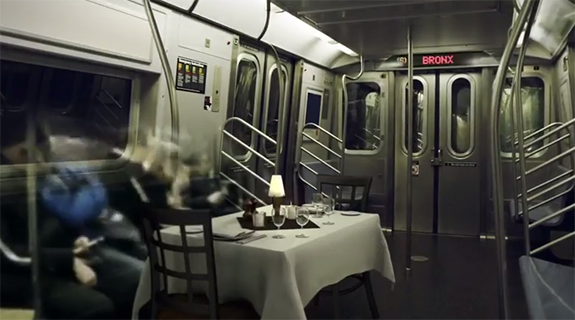You’re about to sit down to a high-end, classy dinner at a cute table for two draped in a crisp white tablecloth … on a subway car. Or on a basketball court during a pickup game; a back alley; a cemetery; a meat locker; in the middle of an intersection as traffic whizzes by.
“It’s this idea that the table represents the restaurant, and there’s the incongruity of trying to create this beautiful, refined dining experience in these rough and tumble spots,” said William Lebeda, creative director at Picturemill, the agency behind the main titles for AMC’s Feed the Beast.
RELATED: HOT SPOT: ‘Feed the Beast’ Main Titles
The sequence stands as a metaphor for the series, starring David Schwimmer and Jim Sturgess as best friends on the brink of losing everything, who embark on their dream of opening an upscale restaurant in the Bronx. The juxtaposition of their admirable struggle to bring the business to life, combined with their collective troubled pasts—Dion (Sturgess) is a brilliant chef in deep with the mob and Tommy (Schwimmer) is haunted by the death of his wife—is captured by the positioning of the elegant table in gritty, ridiculous spots around New York City.
Shots of the table are interjected with footage of the food’s journey to the customer: lambs in a pen; a purchase at the butcher shop; meat cooking over an open flame; the presentation on the plate. The closer the meal gets to that final stage, the more difficult the table becomes to reach.
“It’s two guys trying hard to make a beautiful thing in an ugly world, and we’re trying to heighten this fact,” Lebeda said.
RELATED: David Schwimmer Obliviously Takes a Reservation in ‘Feed the Beast’ Promo
Lebeda also wanted to use the main titles to highlight the brutality of cooking and eating that’s removed from the daily lives of most people.
“What we end up with on our table is far from the lamb in the field,” he said. It was a message that Feed the Beast writer and executive producer Clyde Phillips didn’t want to get lost, and something Lebeda took to heart throughout the creative process. For visuals of roasting the lamb over a fire and cutting into it, Lebeda and his team, with the help of a chef, cooked up their own chops to get the footage they needed.
“It was more hands on than your typical experience,” Lebeda said about creating the opening titles.

He also took a hands-on approach when working with AMC. Lebeda read through a few scripts from the show, and he and Phillips began with an open, collaborative discussion where they talked through different ideas.
Lebeda said he approaches every project differently to capture the essence and tone of the series through a main title sequence.
“The show will tell you what it needs,” he said. “The project will help guide you—you just need to be listening.”
Picturemill presented AMC with five or six concepts and after getting an enthusiastic response to the table idea,Lebeda and his team flew from Los Angeles to New York to present the proposed spot in person before the agency was hired.
Picturemill stuck around to film footage in the city—“at that point we knew exactly what we needed to shoot,” Lebeda said—and combined the shots with stock material from the series. The team digitally composited the dining table into scenes of the Bronx for the sequence. The whole process began in February and wrapped up about 10 weeks later in mid-May.
“I feel really proud of the fact that we shot almost all of it,” Lebeda said.
Picturemill also created the Feed the Beast logo featured across multiple platforms, including online and print promotions, and in the main titles themselves.

In coming up with the design, brainstorming led to the concept of hunters and prey, which led to the idea of the wolf and the lamb, which serves as a visual metaphor of “feeding the beast.”
Additionally, the show’s characters Dion and Tommy encompass both the lamb being stalked, and the relentlessness of a wolf on the hunt, as they got to extremes to see their restaurant succeed.
“You need that ambition and ruthlessness,” Lebeda said, “to create something when there’s so many challenges.”
Tags:













































__twocolumncontent.jpg)











